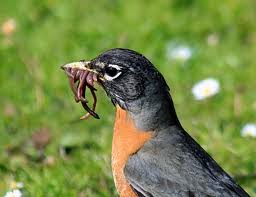Fossils give us a hint of strange
creatures that walked the earth before man existed. There is an
universal appeal about holding something that is millions of years old in your
hand.
Fossilisation is a term for a number of processes that preserve
organic remains. Fossils can include plant and animal remains, impressions
and moulds. Ancient fossil groups include dinosaurs, ammonites and
trilobites.
They can be formed in several ways. Dead animals and plants can be preserved in amber, peat bogs, tar pits, or in ice. Casts or impressions, such as foot prints, can be covered by layers of sediments which eventually become rock and so preserve the casts. Hard body parts such as bones, shells and leaves, can be covered by layers of sediments and over time the parts are gradually replaced by minerals.
Most organisms decay without leaving a fossil record but sometimes conditions are favourable for preservation of plant and animal material, and this is when fossils are created.
They can be formed in several ways. Dead animals and plants can be preserved in amber, peat bogs, tar pits, or in ice. Casts or impressions, such as foot prints, can be covered by layers of sediments which eventually become rock and so preserve the casts. Hard body parts such as bones, shells and leaves, can be covered by layers of sediments and over time the parts are gradually replaced by minerals.
Most organisms decay without leaving a fossil record but sometimes conditions are favourable for preservation of plant and animal material, and this is when fossils are created.
There is no defined scientific date for a fossil, although it is broadly
accepted to include items over ten thousand years old. The oldest
fossil recordings date back 3.5 billion years.
Fossilisation can occur in several ways but the key to successful fossilisation is quick burial, low oxygen levels and minimal disturbance. A rapid burial of sediment can entomb a specimen and protect remains from damage by heat or compaction. It also prevents disturbance of the body by predators. Low oxygen levels slow the decay of the specimen enabling better preservation.
Fossilisation can occur in several ways but the key to successful fossilisation is quick burial, low oxygen levels and minimal disturbance. A rapid burial of sediment can entomb a specimen and protect remains from damage by heat or compaction. It also prevents disturbance of the body by predators. Low oxygen levels slow the decay of the specimen enabling better preservation.
Over time more sediment is deposited on the specimen. The weight of this
sediment compacts the sediment grains together, pushing out any water.
The soft sediment slowly turns to rock in a process called
lithification. Minerals contained within the sediment slowly replace the
minerals present within the skeleton, filling any voids left as
the skeleton dissolves. This leaves a re-mineralised copy of
the original skeleton which is the fossil we see today.
Fossils
are particularly preserved when sediments are deposited beneath
water. It is often possible to trace their movement in the
fossilised sediment. Even fossils preserved on land are more commonly
preserved in wetlands, lakes, rivers and estuaries.
Arguably, one of the most famous dinosaur fossils discovered is the feathered Archaceopteryx, which was found in 1861. This feathered dinosaur lived in the late Jurassic period 150 million years ago and showed the link between dinosaurs and birds. Since than more than 20 species of dinosaurs with feathers have been discovered.
For related articles click onto:
Acid rain and its effect on wildlife
Archaeopteryx
Can starfish grow back their arms?
Caring for the coral reefs
Causes of acid rain
Coral reefs and the greenhouse effect
Conserving fossil fuels
Energy saving light bulbs
Fossil plants
Famous fossils
Fossils: Venericardia
Fossils: Turritella
Fossil Fuels
Fossil fuels: Alternative sources of energy
Fossil hunting at Bracklesham Bay
How are fossils formed?
How many seas are there in the world?
Keystone species
Star Starfish
What is a cuttlefish?
What is a sea anemone?
What is a starfish?
What is a loofah?
What is the greenhouse effect?
What is a sea sponge?
What is a sea cucumber?
What is the difference between an asteroid and a comet?
What is the difference between hibernation and sleep?
What is the difference between a fog and a mist?
What is a fossil?
What is acid rain?
What is fracking?
What is global warming?
What is the greenhouse effect?
What is the Gulf Stream?
Where are fossils found?
Acid rain and its effect on wildlife
Archaeopteryx
Can starfish grow back their arms?
Caring for the coral reefs
Causes of acid rain
Coral reefs and the greenhouse effect
Conserving fossil fuels
Energy saving light bulbs
Fossil plants
Famous fossils
Fossils: Venericardia
Fossils: Turritella
Fossil Fuels
Fossil fuels: Alternative sources of energy
Fossil hunting at Bracklesham Bay
How are fossils formed?
How many seas are there in the world?
Keystone species
Star Starfish
What is a cuttlefish?
What is a sea anemone?
What is a starfish?
What is a loofah?
What is the greenhouse effect?
What is a sea sponge?
What is a sea cucumber?
What is the difference between an asteroid and a comet?
What is the difference between hibernation and sleep?
What is the difference between a fog and a mist?
What is a fossil?
What is acid rain?
What is fracking?
What is global warming?
What is the greenhouse effect?
What is the Gulf Stream?
Where are fossils found?



























